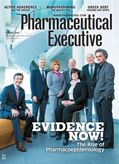Alzheimer’s Update: What to Make of Latest Buzz
Pharmaceutical Executive
Alzheimer’s disease (AD) researchers have seen more than their share of hopefulness and disillusionment over the years. Recent apparent gains targeting one of the disease’s two molecular bull’s-eyes may have reinvigorated drug development, or it may have set developers and investors up for letdown once more. To follow the news coming out of July’s Alzheimer’s Association International Conference in Washington, one had to be prepared for both glass half-full and half-empty interpretations.
Alzheimer’s disease (AD) researchers have seen more than their share of hopefulness and disillusionment over the years. Recent apparent gains targeting one of the disease’s two molecular bull’s-eyes may have reinvigorated drug development, or it may have set developers and investors up for letdown once more. To follow the news coming out of July’s Alzheimer’s Association International Conference in Washington, one had to be prepared for both glass half-full and half-empty interpretations.
Casey McDonald

Consider headlines targeting the uninitiated public for Eli Lilly’s solanezumab, which read as showing “promising results” and displaying the potential to “slow decline.” The news for solanezumab may in fact be positive, considering the anti-amyloid antibody had been largely discounted after prior Phase III failures. But saved by post hoc analysis, the drug is seeing new life in a subset of milder patients who may show benefit when treated early enough.
Most of the optimism in AD comes from company press releases, and regurgitation and aggregation of said releases. The articles offer positive news to click on followed up with minimal insight, and perhaps some words from doctors who are either involved in the trial, or just in the field and as hopeful as their patients. Their call for caution to await larger, late-stage trials is frequently buried in the last few paragraphs.
Media targeting the more experienced biopharma-minded and investing professionals displayed more measured optimism, and ranged to “slight disappointment.” The investment community, having been repeatedly bitten by the AD dog, showed little enthusiasm for solanezumab’s potential with Lilly’s stock down over 3% during the week of the conference.
Results for Biogen the same week were far less rosy. After pumping up its anti-amyloid agent, aducanumab, with positive data in March, July’s presentation at the research conference failed to impress. At week’s end, the AD flop did little to stave off a stock tumble that saw Biogen’s stock lose 22% after its mid-year earnings call in which the company announced it had missed on revenue estimates and cut its 2015 earnings outlook.
Bruce Booth of Life Sci VC and Twitter fame, offered some perspective on the scale of Biogen’s losses, from +$380/share to around $300/share, more value ($20 billion+) than all of venture capital funding into biotech over the past four years combined. Surely the drop had multiple factors, namely Biogen’s unimpressive sales growth for its multiple sclerosis drug, Tecfidera, but the AD disappointment didn’t help.
Of course, the AD field has learned not to make too much of preliminary conclusions. Both products are still enmeshed in Phase III trials that have more important data readouts to come, and both companies remain optimistic, eyeing the massive potential markets that an AD treatment could bring.
Things could be worse. At least the beta amyloid-targeting therapies have Phase III trials of which to speak. Researchers have made far less progress against tangles, AD’s stepchild mechanism of action.
But chasing down secondary targets may be doubtful, as funding remains inadequate. In order to see real progress in AD, researchers at the July conference said there needs to be $2 billion a year in funding; the 2014 NIH spend was a paltry $560 million, tweeted MSNBC’s Meg Tirrell. The Obama administration’s proposed budget for NIH spending on AD in 2016 is $638 million, which still would have to get Congress’ approval, according to a report in theLA Times.
Also worse off, according to the AD conference? Women. According to research at the conference, women decline twice as fast as men and their brains contain higher levels of amyloid.
But there were a few bright spots concerning AD research. The field is definitely making strides with better diagnostics, hinting at a future spit-in-a-cup diagnostic option for earlier screening of the disease. What value diagnoses hold sans treatments, besides frightening the patient, remains a question. There are bright spots for symptom alleviation. Avanir Pharmaceuticals’ Nuedexta showed positive data alleviating pseudobulbar agitation secondary to AD, a symptom that can make AD patients extremely difficult for families to manage, according to a NBC News report.
Finally, the AD headlines from July’s conference that likely received the largest collective sigh: as in all walks of life, we’re probably better off with less TV and more exercise. In response to the potential prescription for more exercise, The Onion said, “There must be some other way.”
Casey McDonald is Pharm Exec’s Senior Editor. He can be reached at cmcdonald@ advanstar.com.

Addressing Disparities in Psoriasis Trials: Takeda's Strategies for Inclusivity in Clinical Research
April 14th 2025LaShell Robinson, Head of Global Feasibility and Trial Equity at Takeda, speaks about the company's strategies to engage patients in underrepresented populations in its phase III psoriasis trials.
Key Findings of the NIAGARA and HIMALAYA Trials
November 8th 2024In this episode of the Pharmaceutical Executive podcast, Shubh Goel, head of immuno-oncology, gastrointestinal tumors, US oncology business unit, AstraZeneca, discusses the findings of the NIAGARA trial in bladder cancer and the significance of the five-year overall survival data from the HIMALAYA trial, particularly the long-term efficacy of the STRIDE regimen for unresectable liver cancer.
Expanding Immune Response Testing to Support Vaccine Development
April 22nd 2025Nigel McCracken, chief operating officer, Virax Biolabs, discusses the expansion of its ViraxImmune platform into areas such as transplant monitoring, vaccine efficacy, latent virus reactivation, and CAR T cell therapy.